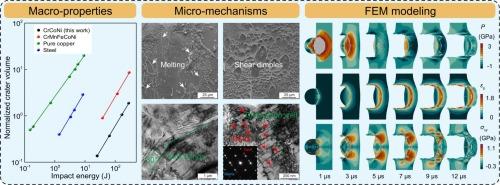中熵CrCoNi合金板的弹道冲击响应与机制:实验与数值模拟
IF 6.3
2区 材料科学
Q2 CHEMISTRY, PHYSICAL
引用次数: 0
摘要
与其他中、高熵合金(MEAs和HEAs)相比,CrCoNi MEA在高应变率下表现出最高的动态抗拉强度(包括碎片强度),这使其成为有希望的防护结构候选材料。然而,其弹道反应和相关的变形/损伤机制尚未得到充分研究。在这项工作中,首次使用直径为5毫米的钢弹对5毫米厚的CrCoNi MEA进行了弹道冲击试验。动态过程用原位高速光学成像捕捉。通过一系列技术对撞击回收的样品进行了全面表征。随着撞击速度的增加,归一化陨石坑直径略有增加,而归一化陨石坑深度和陨石坑体积显著增加。归一化直径(dc*)、深度(dc*)和体积(Vc*)随撞击速度(vi)的变化遵循不同指数的幂律,即dc*∝vi0.25、dc*∝vi4∕3和Vc*∝vi2。此外,与具有相似密度的传统合金(例如铜和钢)以及CrMnFeCoNi HEA相比,CrCoNi MEA具有优越的抗渗透性能。这种优异的抗弹道冲击性能主要归功于CrCoNi MEA的最高动态极限拉伸强度。显微结构分析揭示了CrCoNi靶内的一系列变形特征,包括位错、扭结带、层错、lomo - cottrell锁和纳米孪晶。这些微观组织特征在适应CrCoNi MEA的高应变速率压缩和剪切变形中起着至关重要的作用。此外,利用Johnson-Cook本构模型和损伤准则进行的数值模拟有效地再现了实验观察结果,证实了该模型在预测CrCoNi MEA弹道冲击行为方面的鲁棒性。本文章由计算机程序翻译,如有差异,请以英文原文为准。

Ballistic impact responses and mechanisms of medium-entropy CrCoNi alloy plates: Experiments and numerical modeling
Compared to other medium- and high-entropy alloys (MEAs and HEAs), CrCoNi MEA demonstrates the highest dynamic tensile strength (including spall strength) at elevated strain rates, which renders it a promising candidate material for protective structures. Nevertheless, its ballistic responses and associated deformation/damage mechanisms have not been fully investigated. In this work, ballistic impact tests are, for the first time, performed on a 5-mm-thick CrCoNi MEA using a 5-mm-diameter steel projectile. The dynamic process is captured with in situ high-speed optical imaging. Impact-recovered samples are comprehensively characterized through a series of techniques. As the impact velocity increases, the normalized crater diameter increases slightly, while the normalized crater depth and crater volume increase significantly. The three crater parameters, including the normalized diameter (), depth (), and volume (), as a function of impact velocity (vi) follow power laws with different exponents, i.e., , and . Furthermore, the CrCoNi MEA exhibits superior penetration resistance compared to conventional alloys with similar densities (e.g., copper and steel), as well as the CrMnFeCoNi HEA. This superior ballistic impact resistance is mainly attributed to the highest dynamic ultimate tensile strength of the CrCoNi MEA. Microstructural analyses reveal a range of deformation features within the CrCoNi target, including dislocations, kink bands, stacking faults, Lomer-Cottrell locks, and nano-twins. These microstructural characteristics play a crucial role in accommodating the high strain rate compression and shear deformation of the CrCoNi MEA. Additionally, numerical simulations utilizing the Johnson-Cook constitutive model and damage criterion effectively reproduce the experimental observations, confirming the robustness of the model in predicting the ballistic impact behavior of CrCoNi MEA.
求助全文
通过发布文献求助,成功后即可免费获取论文全文。
去求助
来源期刊

Journal of Alloys and Compounds
工程技术-材料科学:综合
CiteScore
11.10
自引率
14.50%
发文量
5146
审稿时长
67 days
期刊介绍:
The Journal of Alloys and Compounds is intended to serve as an international medium for the publication of work on solid materials comprising compounds as well as alloys. Its great strength lies in the diversity of discipline which it encompasses, drawing together results from materials science, solid-state chemistry and physics.
 求助内容:
求助内容: 应助结果提醒方式:
应助结果提醒方式:


